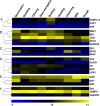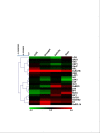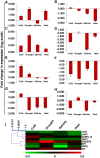Narrowing down the targets for yield improvement in rice under normal and abiotic stress conditions via expression profiling of yield-related genes
- PMID: 24280046
- PMCID: PMC4883727
- DOI: 10.1186/1939-8433-5-37
Narrowing down the targets for yield improvement in rice under normal and abiotic stress conditions via expression profiling of yield-related genes
Abstract
Background: Crop improvement targeting high yield and tolerance to environmental stresses has become the need of the hour. Yield improvement via breeding or gene pyramiding aiming comprehensive incorporation of the agronomically favored traits requires an in-depth understanding of the molecular basis of these traits. The present study describes expression profiling of yield-related genes in rice with respect to different developmental stages and various abiotic stress conditions.
Results: Our analysis indicates developmental regulation of the yield-related genes pertaining to the genetic reprogramming involved at the corresponding developmental stage. The gene expression data can be utilized to specifically select particular genes which can potentially function synergistically for enhancing the yield while maintaining the source-sink balance. Furthermore, to gain some insights into the molecular basis of yield penalty during various abiotic stresses, the expression of selected yield-related genes has also been analyzed by qRT-PCR under such stress conditions. Our analysis clearly showed a tight transcriptional regulation of a few of these yield-related genes by abiotic stresses. The stress-responsive expression patterns of these genes could explain some of the most important stress-related physiological manifestations such as reduced tillering, smaller panicles and early completion of the life cycle owing to reduced duration of vegetative and reproductive phases.
Conclusions: Development of high yielding rice varieties which maintain their yield even under stress conditions may be achieved by simultaneous genetic manipulation of certain combination of genes such as LRK1 and LOG, based on their function and expression profile obtained in the present study. Our study would aid in investigating in future, whether over-expressing or knocking down such yield-related genes can improve the grain yield potential in rice.
Figures





Similar articles
-
Enhancement of Plant Productivity in the Post-Genomics Era.Curr Genomics. 2016 Aug;17(4):295-6. doi: 10.2174/138920291704160607182507. Curr Genomics. 2016. PMID: 27499678 Free PMC article.
-
Plant omics: genome-wide analysis of ABA repressor1 (ABR1) related genes in rice during abiotic stress and development.OMICS. 2013 Aug;17(8):439-50. doi: 10.1089/omi.2012.0074. OMICS. 2013. PMID: 23895290
-
Development of introgression lines in high yielding, semi-dwarf genetic backgrounds to enable improvement of modern rice varieties for tolerance to multiple abiotic stresses free from undesirable linkage drag.Sci Rep. 2020 Aug 4;10(1):13073. doi: 10.1038/s41598-020-70132-9. Sci Rep. 2020. PMID: 32753648 Free PMC article.
-
Integrating the dynamics of yield traits in rice in response to environmental changes.J Exp Bot. 2020 Jan 7;71(2):490-506. doi: 10.1093/jxb/erz364. J Exp Bot. 2020. PMID: 31410470 Review.
-
Recent Molecular Aspects and Integrated Omics Strategies for Understanding the Abiotic Stress Tolerance of Rice.Plants (Basel). 2023 May 18;12(10):2019. doi: 10.3390/plants12102019. Plants (Basel). 2023. PMID: 37653936 Free PMC article. Review.
Cited by
-
Coordinated regulation of photosynthesis in rice increases yield and tolerance to environmental stress.Nat Commun. 2014 Oct 31;5:5302. doi: 10.1038/ncomms6302. Nat Commun. 2014. PMID: 25358745 Free PMC article.
-
Transcriptome analysis of Oryza sativa in responses to different concentrations of thiocyanate.Environ Sci Pollut Res Int. 2019 Apr;26(12):11696-11709. doi: 10.1007/s11356-019-04544-0. Epub 2019 Feb 26. Environ Sci Pollut Res Int. 2019. PMID: 30806930
-
MATH-Domain Family Shows Response toward Abiotic Stress in Arabidopsis and Rice.Front Plant Sci. 2016 Jun 28;7:923. doi: 10.3389/fpls.2016.00923. eCollection 2016. Front Plant Sci. 2016. PMID: 27446153 Free PMC article.
-
A point mutation in the zinc finger motif of RID1/EHD2/OsID1 protein leads to outstanding yield-related traits in japonica rice variety Wuyunjing 7.Rice (N Y). 2013 Oct 18;6(1):24. doi: 10.1186/1939-8433-6-24. Rice (N Y). 2013. PMID: 24280027 Free PMC article.
-
Roles of phytohormone changes in the grain yield of rice plants exposed to heat: a review.PeerJ. 2019 Nov 19;7:e7792. doi: 10.7717/peerj.7792. eCollection 2019. PeerJ. 2019. PMID: 31763066 Free PMC article.
References
-
- Hiei Y, Komari T. Improved protocols for transformation of indica rice mediated by Agrobacterium tumefaciens. Plant Cell, Tissue and Organ cult. 2006;85:271–554. doi: 10.1007/s11240-005-9069-8. - DOI
LinkOut - more resources
Full Text Sources

